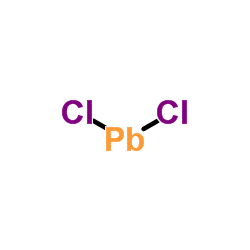氯化铅

氯化铅结构式

|
常用名 | 氯化铅 | 英文名 | pbcl2 |
|---|---|---|---|---|
| CAS号 | 7758-95-4 | 分子量 | 278.106 | |
| 密度 | 5.85 g/mL at 25 °C(lit.) | 沸点 | 950 °C(lit.) | |
| 分子式 | Cl2Pb | 熔点 | 501 °C(lit.) | |
| MSDS | 中文版 美版 | 闪点 | 951°C | |
| 符号 |



GHS07, GHS08, GHS09 |
信号词 | Danger |
|
Antioxidative role of cerium against the toxicity of lead in the liver of silver crucian carp.
Fish Physiol. Biochem. 36(3) , 367-76, (2010) The antioxidative role of cerium was investigated in the liver of silver crucian carp injected with lead. The fish were intraperitoneally injected with 10, 20, or 30 mg/kg wet weight PbCl(2). After a 14-day period of incubation, 35 animals were injected with ... |
|
|
Genotoxicity testing of two lead-compounds in somatic cells of Drosophila melanogaster.
Mutat. Res. 724(1-2) , 35-40, (2011) The in vivo genotoxic activity of two inorganic lead compounds was studied in Drosophila melanogaster by measurement of two different genetic endpoints. We used the wing-spot test and the comet assay. The comet assay was conducted with larval haemocytes. The ... |
|
|
Pleural effects of indium phosphide in B6C3F1 mice: nonfibrous particulate induced pleural fibrosis.
Exp. Lung Res. 35(10) , 858-82, (2009) The mechanism(s) by which chronic inhalation of indium phosphide (InP) particles causes pleural fibrosis is not known. Few studies of InP pleural toxicity have been conducted because of the challenges in conducting particulate inhalation exposures, and becaus... |
|
|
mRNA expression is a relevant tool to identify developmental neurotoxicants using an in vitro approach.
Toxicol. Sci. 113(1) , 95-115, (2010) So far, only a few industrial chemicals have been identified as developmental neurotoxicants. Because the current developmental neurotoxicity (DNT) guideline (Organisation for Economic Co-operation and Development TG 426) is based entirely on in vivo studies ... |
|
|
Lead hepatotoxicology: a study in an animal model.
Toxicol. Ind. Health 28(2) , 108-13, (2012) The increasing use of lead (Pb) for industrial purposes has resulted in the significant increase in environmental contamination of our planet especially in concern to water and food. In this study using the electron scanning microscopy (SEM), the authors show... |
|
|
Electronic properties of PbCl2 and PbBr2 using Compton scattering technique.
Appl. Radiat. Isot. 67(6) , 1050-6, (2009) We present the electron momentum densities of PbCl(2) and PbBr(2) using 661.65 keV gamma-rays from 20 Ci (137)Cs source. To supplement our experimental investigations, we also report energy bands, density of states, Mulliken's population and Compton profiles ... |
|
|
Lead chloride affects sperm motility and acrosome reaction in mice: lead affects mice sperm motility and acrosome reaction.
Cell Biol. Toxicol. 25(4) , 341-53, (2009) Lead is highly toxic and persistent in the environment and, thus, a major concern for public health. In this study, the effects of lead chloride (PbCl2) on mouse epididymal sperm were evaluated. Male mice were subcutaneously injected with 74 and 100 mg PbCl2/... |
|
|
Genetic damage induced by lead chloride in different tissues of fresh water climbing perch Anabas testudineus (Bloch).
Environ. Monit. Assess. 182(1-4) , 197-204, (2011) The present investigation was undertaken to study the induction of DNA damage by lead chloride (PbCl(2)) in freshwater climbing perch Anabas testudineus using alkaline single cell gel electrophoresis (comet assay). Based on the LC(50) values of lead chloride ... |
|
|
Superstatistics analysis of the ion current distribution function: Met3PbCl influence study.
Eur. Biophys. J. 39(10) , 1397-406, (2010) A novel analysis of ion current time series is proposed. It is shown that higher (second, third and fourth) statistical moments of the ion current probability distribution function (PDF) can yield new information about ion channel properties. The method is il... |
|
|
Bio-accumulation and toxicity of lead (Pb) in Lemna gibba L (duckweed).
J. Environ. Sci. Health. A. Tox. Hazard. Subst. Environ. Eng. 45(1) , 107-10, (2010) The vascular aquatic plant Lemna gibba (duckweed) was exposed during seven days to lead (Pb) at concentrations ranging from 50 to 300 mg/L in a greenhouse with controlled photoperiod and temperature. The effects of Pb on growth of Lemna gibba were examined du... |